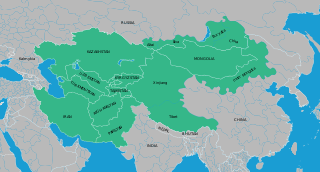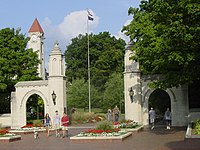
Ural-Altaic, Uralo-Altaic or Uraltaic is a linguistic convergence zone and former language-family proposal uniting the Uralic and the Altaic languages. It is generally now agreed that even the Altaic languages do not share a common descent: the similarities among Turkic, Mongolic and Tungusic are better explained by diffusion and borrowing. Just as Altaic, internal structure of the Uralic family also has been debated since the family was first proposed. Doubts about the validity of most or all of the proposed higher-order Uralic branchings are becoming more common. The term continues to be used for the central Eurasian typological, grammatical and lexical convergence zone.

Zaya Pandita or Namkhaijamts (1599–1662) was a Buddhist missionary priest and scholar of Oirat origin who is the most prominent Oirat Buddhist scholar. Among his accomplishments is the invention of the Clear Script.

Inner Asia refers to the northern and landlocked regions spanning North, Central and East Asia. It includes parts of western and northeast China, as well as southern Siberia. The area overlaps with some definitions of 'Central Asia', mostly the historical ones, but certain regions that are often included in Inner Asia, such as Manchuria, are not a part of Central Asia by any of its definitions. Inner Asia may be regarded as the western and northern "frontier" of China proper of the former Qin dynasty and as being bounded by East Asia proper, which consists of China proper, Japan and Korea.
Christopher I. Beckwith is an American philologist and distinguished professor in the Department of Central Eurasian Studies at Indiana University Bloomington, Indiana.

Yuri Enohovich Bregel was one of the world's leading historians of Islamic Central Asia. He published extensively on Persian- and Turkic-language history and historiography, and on political, economic and ethnic history in Central Asia and the Muslim world. He lived in the Soviet Union (1925–1974), Israel (1974–1981), and the United States (1981–2016).
The Office of the Provost at Indiana University Bloomington oversees the academic programs, research, and policies of 16 schools on the Indiana University Bloomington campus. Together, these units offer more than 550 individual degree programs and majors.
Central Asian studies is the discipline of studying the culture, history, and languages of Central Asia. The roots of Central Asian studies as a social science discipline goes to 19th century Anglo-Russian Great Game. During the 19th century, Central Asia became a subject of systematical information collection and organization thanks to the numerous travels made by British and Russian agents, soldiers, scholars into the region. After the collapse of the Soviet Union, interest in the field increased considerably. Central Asian studies in contemporary times is represented by a plethora of prominent scholars, institutions and academic programs throughout the world.
M. Nazif Shahrani is a professor of anthropology, Central Asian Studies, and Middle Eastern Studies at Indiana University, Bloomington.
Devin Deweese is a professor of Islamic and Central Eurasian Studies at Indiana University, Bloomington.
The Proto-Altaic language is a hypothetical and controversial extinct language that has been proposed as the common ancestor of the disputed Altaic languages.
John Richard Krueger was a professor at Indiana University, specialized in studies of Chuvash and Yakut, and Mongolian languages. His approximately 20 books are the standard works, each held in about one hundred United States research libraries. One of his most important contributions is that he translated numerous non-English sources and books into English, such as György Kara's Books of the Mongolian nomads : more than eight centuries of writing Mongolian.
Denis Sinor was a Distinguished Professor Emeritus of Central Asian Studies at the Department of Central Eurasian Studies at Indiana University and a tenured lecturer at Cambridge University between 1948 and 1962, and was one of the world's leading scholars for the history of Central Asia. Under his directorship, the Central Asian Studies at Indiana University became one of the world's foremost centers for Central Asian history, languages and linguistics.
Kahar Barat is a Uyghur American historian known for his work on Buddhism and Islam in Xinjiang.
Luc Kwanten was a Belgian sinologist, Tangutologist and literary agent.
Mongolian studies is an interdisciplinary field of scholarly inquiry concerning Mongolian language, Mongolian history, and Mongolian culture. Scholars who work in the field of Mongolian studies are often referred to as Mongolists.
The Indiana University Language Workshop is one of the oldest and largest summer language programs in the United States. Located on the Bloomington campus of Indiana University (IU), the workshop was founded in 1950 at the height of the Cold War to provide intensive training in Russian and later other less commonly taught foreign languages. For the almost 75 years of its existence, the Workshop has provided language training to over ten thousand students. It is widely known in the United States for its quality and variety, especially among university programs in Slavic, East European and Central Eurasian studies.
Jamsheed K. Choksy is a Distinguished Professor, former Chair of the Department of Near Eastern Languages and Cultures, former Chair of the Department of Central Eurasian Studies, and current Director of the Inner Asian and Uralic National Resource Center at Indiana University - Bloomington. Choksy completed his undergraduate degree from Columbia University in 1985 and doctoral work at Harvard University in 1991 where he was elected a Junior Fellow (1987-1991). From there, he embarked on a career in academia, beginning as a Visiting Assistant Professor at Stanford University (1991-1993) and subsequently a tenure track professor at Indiana University in 1993, eventually holding appointments in a variety of different programs in that university. He has been a NEH Fellow and Member at the School of Historical Studies, Institute for Advanced Study in Princeton (1993-1994) and a Mellon Fellow at the Center for Advanced Study in the Behavioral Sciences, Palo Alto (2001-2002).

This is a timeline of the Karluks. The Kara-Khanid Khanate is also included; however, it is disputed whether the Karluks or Yagmas were the dominant group within the khanate.






